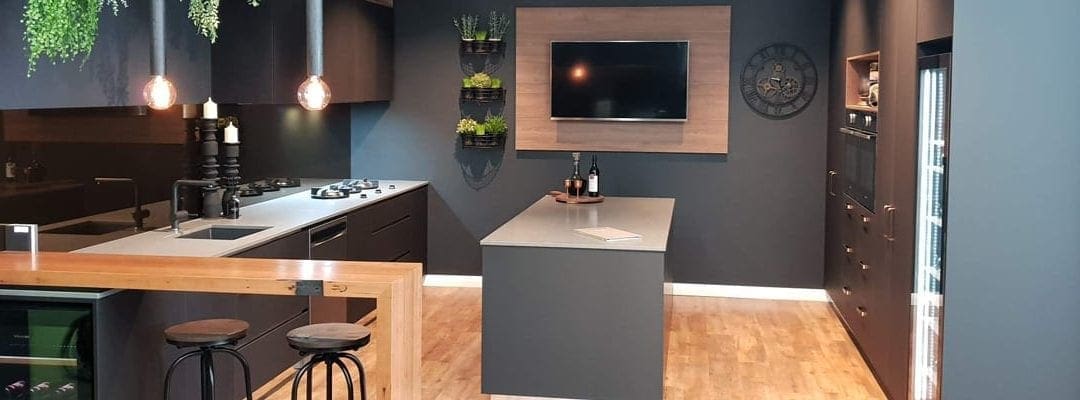Industrial style kitchens are tipped to be a hot trend in 2019 kitchen design. Let’s take a look at the key features of this distinctive style and uncover just what is making it so popular.
Although the concept of industrial style kitchens in homes is not new to the kitchen industry, this particular style has certainly gathered momentum in recent times and is now being requested in growing numbers. You might be thinking, “That sounds interesting, but what exactly is an industrial style kitchen anyway?”
Origins of Industrial Style Home Design
The industrial style home, and this includes kitchens, is thought to have its origins in 1950s America. The folk of the creative industries such as artists, painters, sculptors and designers found that abandoned factories and similar unused buildings provided the perfect canvas for them to create unique spaces where they could combine both their professional and personal life. They transformed the internal shell, maintaining the inherent style and features of the original building and expanded on those elements to create their ideal blended space.
Industrial Style Kitchens Today
Gaining popularity over the past few years, industrial style kitchens have evolved to become a fusion of both industrial and commercial elements and are currently appearing in homes at an ever-increasing rate. The unique and contemporary appearance of this style combined with the natural rustic and hard-wearing nature of the industrial and commercial inspired surfaces and materials that are indicative of this style makes it a great choice for those who want a the best of both worlds.
More than ever, we are choosing to entertain at home as opposed to venturing out, and so we are using our kitchens differently to how we might have in the past. As a result, the concept of borrowing ideas from the rustic and gritty industrial spaces and the tried and trusted practices of the professional kitchen users and then adapting them for our homes and lifestyles makes a lot of sense.
Is there a style guide for the industrial style kitchen?
One of the reasons that the industrial style may not be so easy to understand is that there is not necessarily a strict rulebook to follow in terms of design elements and style. Whilst there are often some commonly found features throughout, the wide scope of the style also very easily lends itself to individual expression and innovation within the loose and varied framework of the style, which makes for some truly unique and amazing spaces. Maybe a legacy of the artistic innovators of the style?
How can I identify an industrial style kitchen?
Perhaps the most telling part of an industrial style kitchen is the types, as well as the combination, of materials that are used. Typical materials found in kitchens of this style include timber, concrete and stainless steel. Exposed brick, either painted or left bare, is also a popular feature of this style. Whilst these materials can sometimes be found in other design styles, when they comprise a large portion of the space, you can be pretty certain it is an industrial inspired style.
As we have mentioned, there is no rulebook to creating an industrial style kitchen and so it is not uncommon to see an eclectic mix of contemporary polyurethane cabinetry finishes with stainless steel bench tops. Or concrete walls with timber cabinets. Anything goes really. The more texture, interest and creativity you can inject into the space, the better.
Due to continuing advances in material manufacturing and engineering, contemporary industrial style kitchens may contain engineered materials that are designed to replicate the look of timber or concrete. These materials provide the same visual impact whilst minimising some of the features that may be less desirable such as the maintenance and upkeep or durability of the natural products.
Having said that, another distinguishing feature of the industrial style kitchen is that they are not necessarily as pristine and polished as other kitchen style present. It is for this reason that some might prefer to use the original materials as opposed to the engineered replicas, authenticity. It is not unusual for there to be visible marks and scrapes and imperfections and often no attempt is made to conceal or rectify what some might see as supposed “flaws”. These evident signs of hard work and wear-and-tear speak to the truth that it has been inspired by the themes of production and industry and is primarily built to be a workspace and it makes no apologies for that. These natural and “accidental” features also act to further enhance the unique character of the space.
What else will I notice?
The use of industrial materials such as timber, steel and concrete is not just restricted to the cabinets and bench tops. Think timber and metal stools, rustic wide-beam floorboards and polished concrete floors. Incorporating reused or repurposed materials and items wherever possible is another distinctive feature of the industrial style.
Continuing on with the typical elements of the industrial spaces on which this style is modelled, exposed fittings and fixtures are also indicative of this style. Industrial style kitchens showcase exposed ceiling beams, pipework and ducting. Don’t be fooled into thinking that the worn-in and well-used look means less work to design and maintain. In some cases, achieving this look can require more detailed planning, execution and ongoing maintenance as you will need to consider whether those items that might ordinarily be hidden, and are now on display, may require a different material or application than would usually be suitable for that purpose. For example you might consider rigid air conditioning ducting or a superior quality timber for the ceiling beams.
It’s not only the fixtures and fittings that are on display. Open shelving and cutlery rails that mimic commercial kitchen set-ups and make for quick and easy access of a cook’s many and varied tools of trade are also common in industrial style kitchens.
Lighting and appliance choices should also continue the industrial and commercial styles. These can be original items sourced from the many great second hand and antique vendors and given a new lease of life, or there are plenty of new products in the market that are specifically designed to reflect this popular style. Steel and black tend to be popular choices when it comes to lighting and appliance choices for industrial style kitchens but chrome, copper, glass and wood also work well.
There is so much room for expression and creativity within an industrial style kitchen. Drawing on the best of choices in both design and function and with the flexibility to combine so many different materials; old and new, and styles; contemporary and antique, and everything in between, it really can be whatever you want it to be.
Harrington Kitchens have a wealth of expertise in creating kitchens of every style. They pride themselves on being at the forefront of kitchen design trends and consistently delivering kitchens of the highest quality. Contact our team on 1300 662 112, submit an online enquiry or visit us at our Narellan or Bowral showrooms to discuss how we can make your dream kitchen a reality.


Recent Comments